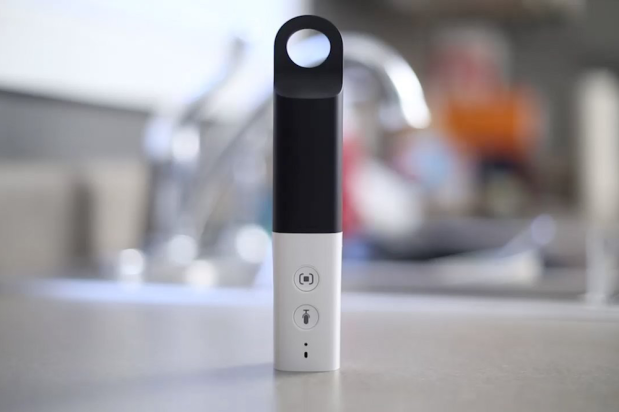Amazon Positions Itself For Online Grocery Dominance With Dash Wand

Amazon’s new voice-activated grocery assistant is practically magic, and you don’t even have to go to Diagon Alley to get it. The company has added Alexa to its Dash Wand product, making it smarter and more capable than ever – and strategically positioning itself to own the emerging online grocery market.
“If the acquisition of Whole Foods wasn’t a clear enough signal of Amazon’s intentions for grocery market domination, the introduction of the Dash Wand provides another glaring indication,” said Igor Gorin, CEO and co-founder of the privately-held eCommerce agency Astound Commerce. “As consumers continue to get more comfortable ordering food online, Amazon is positioning itself at the bleeding edge of that market shift.”
Like the original Dash Wand, the next-generation device sticks to the fridge and lets users scan grocery barcodes, convert measurements and order household goods by voice command. Unlike its predecessor, it then adds items to the Amazon cart and proceeds to checkout when they say so without requiring them to log on to a computer (a hassle that was part of the original Dash Wand experience). It can also look up recipes, restaurants and nutritional information about products, hands-free.
Nick Manzo, Global Omnichannel Lead at the product content solution provider 1WorldSync, thinks that that last point could be the key to finally getting consumers to shift to online grocery shopping.
“Trust has traditionally been difficult to earn online when it comes to food, which is one of the reasons why digital grocery is only now starting to take off,” said Manzo. “The Dash Wand provides enhanced access to nutritional information and recipes, which helps brands gain consumer trust through product transparency. Along with the Whole Foods purchase, the Dash Wand could make Amazon a much more trusted source.”
Manzo noted that today’s grocery shopper puts a lot more deliberation into what goes on their pantry shelves than shoppers used to. He attributes that shift to the increase of food allergies and general health-consciousness. The Dash Wand, he said, will give users access to Amazon’s vast assortment while also allowing them to hone in on the details that matter to them.
Manzo and Gorin were both hard-pressed to think of a reason why the Dash Wand doesn’t represent a brilliant move by the eCommerce giant. The experts agreed that the Wand will be an important player in Amazon’s conquest of the grocery market and has the power to position it as a leader in that vertical.
Gorin projected that AmazonFresh users and consumers who already have an interest in voice commerce are the likeliest targets for the new Wand. However, he said it could also serve as a gateway for potential Amazon customers who have yet to invest in one of the company’s digital assistant devices.
“The Dash Wand is a great entry point into voice commerce for consumers and may motivate those who like the wand’s voice capabilities to make a bigger investment in Amazon’s digital assistant, Alexa,” said Gorin.
He added that the Dash Wand gives Amazon an edge in another space: voice technology. “While Google Home and Apple’s Siri are more focused on convenient information and smart home features, Amazon is razor-focused on using Alexa to further dominate the commerce market,” said Gorin.
Manzo and Gorin agreed that the company may also hope to attract users who have yet to consider using AmazonFresh to buy their groceries. The Dash Wand retails for a very affordable $20, which nets zero for Amazon Prime members after rebates. Buyers also get a free 90-day trial of the AmazonFresh grocery delivery service.
How competitors will respond to this latest development remains to be seen. But respond they must, as consumer distaste for grocery shopping is becoming ever more clear. Shoppers don’t want to waste their most precious commodity – time – trawling crowded aisles to buy food. They want to pick it up on their way home from work or have it delivered to their doorstep.
Manzo predicted that smart grocery stores will soon start providing barcode scanners to customers and investing in new labeling technologies to offer competitive insights into nutritional information. But as the sector hustles to keep up, Amazon will stay ahead by placing more emphasis on supply chain transparency, offering insights on the entire product lifecycle from farm to table.
“The Dash Wand further signals the company’s intent to own that market, and retailers need to prepare for this channel just as they would any other if they want to remain competitive,” said Manzo. “Again, simplicity and convenience are key. E-grocers and traditional brick-and-mortar retailers must recognize the importance of meeting consumers wherever they are, in both the physical and digital space.”
In Other News…
As German discount grocer Lidl opens its first stores on American soil, competitors have already dived into a price war, with Aldi, Walmart, and Amazon all vying to undercut one another.
Denmark’s national debit card Dankort is allowing customers to make touchless payments of up to $30 from their iPhone lock screen simply by placing the phone close to the payment terminal. Larger payments can also be made this way but must be validated using the phone’s biometric thumbprint scanner.
Dover’s new mini grocery store will carry meats and other grocery essentials in an area that hasn’t seen a grocery store in decades. It’s operating out of a meat processing center and will likely partner with local providers to keep its (albeit limited) shelves stocked. Mayor Roger Ihrke hopes it will encourage residents to stay in town.
Danube, one of the largest brick and mortar hypermarkets in the Middle East, has launched an eGrocer platform in Saudi Arabia, where Internet penetration is over 75 percent and projected to reach 90 percent in the near future – the highest in the region. 65 percent of the population falls in the 15-to-54 age bracket, a demographic that is really driving the growth of eCommerce in Saudi Arabia and around the world.